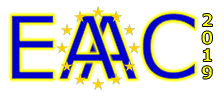Speaker
Description
The interaction of high-power, high-contrast laser pulses with nanostructured targets has largely been explored as a possible way to increase energy absorption and aim to more efficient proton acceleration. In these studies, the costs of target manufacturing and handling are a key factor to establish the soundness of each approach, and while advance of laser technologies now allow preserving the target structures until the interaction with the ultra-intense pulse peak, stringent requirements on target geometries and shapes may hinder their applicability to high repetition rate schemes.
Here we present promising results on the energy enhancement of TNSA-driven proton beams achieved when irradiating sub-µm foils perforated with a non-periodic distribution of nm-size holes. Particle-In-Cell simulations highlight how hot electrons travelling across the nano-holes benefit from a longer interaction with the laser pulse and result in a more efficient sheath field for accelerating the proton beams. The numerical investigation demonstrates the robustness of the mechanisms within a variety of foil thicknesses and hole diameters. Recent experiments performed at the Lund High-Power Laser facility are consistent with the simulation results and confirm the favourable manageability of this target configuration.

